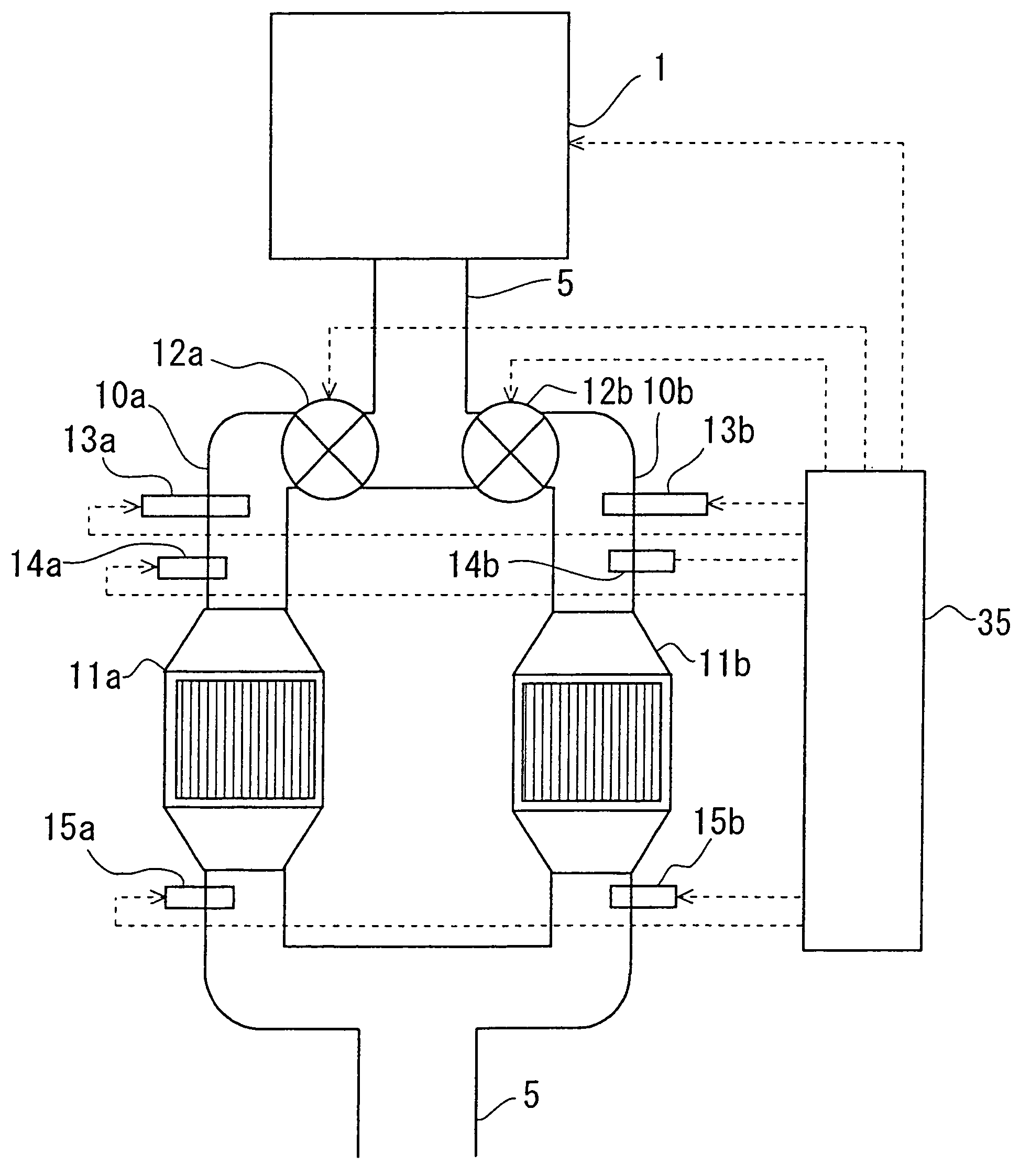Exhaust purification system for internal combustion engine
a purification system and exhaust technology, applied in the direction of machines/engines, mechanical equipment, separation processes, etc., can solve the problems of reduced purification performance, reduced purification performance, and insufficient use of supplied fuel in the oxidation reaction of nox catalysts of storage-reduction type, and achieve more reliable nox reduction treatment
- Summary
- Abstract
- Description
- Claims
- Application Information
AI Technical Summary
Benefits of technology
Problems solved by technology
Method used
Image
Examples
first embodiment
[0055]FIG. 1 is a view showing a schematic configuration of an internal combustion engine, and an exhaust system and a control system thereof, according to a first embodiment of the present invention. Note that the inside of an internal combustion engine 1 and an intake system thereof are omitted in FIG. 1.
[0056]Referring to FIG. 1, the internal combustion engine 1 is connected with an exhaust pipe 5 to which exhaust is distributed from the internal combustion engine 1. The exhaust pipe 5 is connected downstream with a muffler (not shown). In addition, the exhaust pipe 5 branches into a first branch passage 10a and a second branch passage 10b. The first branch passage 10a and the second branch passage 10b meet downstream. The first branch passage 10a is provided with a first NOx catalyst 11a, which stores and reduces NOx in the exhaust, while the second branch passage 10b is provided with a similar second NOx catalyst 11b.
[0057]Also provided in the first branch passage 10a is a fir...
second embodiment
[0112]Next, a second embodiment according to the present invention will be described. For the second embodiment, it is assumed that the value of the added fuel amount F, which is added from the first fuel-adding valve 13a, is preset to a constant value. A control will be described below that determines during the NOx reduction treatment explained in the first embodiment that the fuel added from the first fuel-adding valve 13a is excessively dispersing concentrated at a central portion in the first NOx catalyst 11a, and not dispersing toward portions on the upstream side and downstream side in the first NOx catalyst 11a. Such a determination is made instead determining that the added fuel amount F from the first fuel-adding valve 13a has deviated from an optimum value. In addition, such a determination is made if the absolute value of the deviation between the target air-fuel ratio AFT and the average value of the output AFT of the first upstream-side air-fuel ratio sensor 14a and th...
third embodiment
[0120]Next, a third embodiment according to the present invention will be described. The third embodiment is an example where a plurality of NOx catalysts is provided in series in the first branch passage 10a and the second branch passage 10b. The following description regards performing the NOx reduction treatment for the NOx catalysts provided in, for example, the first branch passage 10a. In this example, a target value of a difference between the output signals of the first upstream-side air-fuel ratio sensor 14a and the first downstream-side air-fuel ratio sensor 15a is set in accordance with an amount of reducer required for each NOx catalyst.
[0121]FIG. 9 shows a schematic configuration of the internal combustion engine 1, and the exhaust system and the control system thereof, according to the present embodiment. FIG. 9 is different from FIG. 1 in that: a first downstream-side NOx catalyst 16a, which is an auxiliary storage-reduction type NOx catalyst, is provided between the ...
PUM
| Property | Measurement | Unit |
|---|---|---|
| concentration | aaaaa | aaaaa |
| length | aaaaa | aaaaa |
| travel speed | aaaaa | aaaaa |
Abstract
Description
Claims
Application Information
 Login to View More
Login to View More - R&D
- Intellectual Property
- Life Sciences
- Materials
- Tech Scout
- Unparalleled Data Quality
- Higher Quality Content
- 60% Fewer Hallucinations
Browse by: Latest US Patents, China's latest patents, Technical Efficacy Thesaurus, Application Domain, Technology Topic, Popular Technical Reports.
© 2025 PatSnap. All rights reserved.Legal|Privacy policy|Modern Slavery Act Transparency Statement|Sitemap|About US| Contact US: help@patsnap.com



